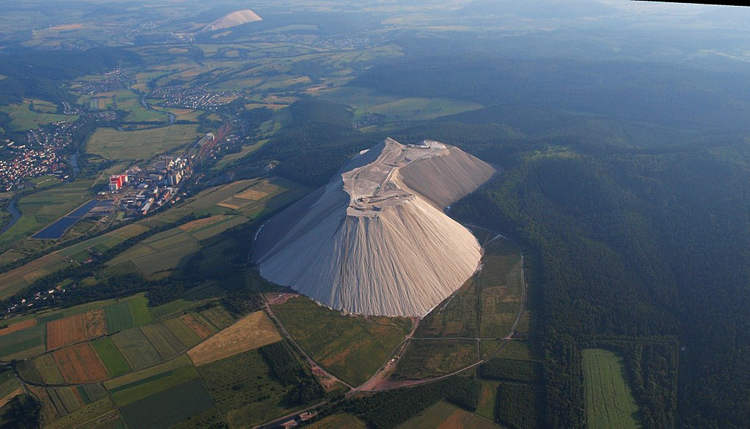The town of Herringen, in central Germany, is home to a heap of sodium chloride (table salt) so massive that it has come to be known as Monte Kali. It is the world’s largest artificial salt mountain.
The origin of Monte Kali can be traced back to the year 1976, when potash salt started being extracted from mines around the town of Hessen. Back then, potash was used to make products like soap and glass, but today it is an important ingredient in several fertilizers, synthetic rubber, and even some medicines, so extraction intensified over the last few decades. The problem with potash is that mining it generates a lot of sodium chloride as a byproduct, so you need somewhere to store it. The company operating the mines started dumping all this salt a few miles from Herringen, and over the years it created a giant salt mountain locals named Monte Kali or Kalimanjaro (puns for Kalisalz, the German word for ‘potash’).

Photo: Wolkenkratzer/Wikimedia Commons
As of 2017, Monte Kali stands at 530 meters (1,740 ft) above sea level and covers an area of over 100 hectares, so calling it an artificial mountain is no exaggeration. You can see it from anywhere in Herringen, or even driving past it on the motorway, and it has become somewhat of a tourist attraction. In fact, at one point, people could pay to ascend this giant waste dump, as part of a guided tour. The ascent took the average person around 15 minutes, and the 23-hectare summit plateau offered views of the entire Werra Valley all the way to the Rhön and the Thuringian Forest.
Although it’s hard to estimate how much salt Monte Kali consists of, most sources we’ve checked put its current mass at approximately 236 million tons. This thing covers an area as large as 114 football fields and is as heavy as 23,600 Eiffel Towers. And with over 1,000 tonnes of table salt being added to it every single hour of the day – about 7.2 million tonnes a year – it’s only getting bigger.
As you can imagine, a salt mountain of this size in the center of Germany, close to forests and the Werra River, does raise some environmental questions. Research has found that the growing heap of salt, which also generates a lot of brine, has caused the Werra to become salty, as has the groundwater in the area. Of the 60 to 100 species of invertebrates that once called the area around Herringen home, only 3 remain.
The above could be described as an environmental disaster, but the potash industry is really big in the region, accounting for several thousand jobs, so closing down production isn’t really an option for authorities. Kali und Salz (K+S), the company operating the mines, had its license extended until 2060, and even had its request to expand Monte Kali by 25 hectares approved in 2020.
In case you were wondering how K+S manages to dump over 1,000 tonnes of sodium chloride on Monte Kali every hour, it does with a 1.5 km-long (0.93 miles) conveyor belt.
Interestingly, Monte Kali is just the largest of several table salt dumps in the region which has come to be known as “Land der weißen Berge” (Land of the White Mountains).












